A Bite of China II - Seasons, diversified delicacies for different time
2014-05-15China travel Guide
China boasts multiple geographical conditions and climate. People sow in spring, cultivate in summer, harvest in autumn and store food in winter. This strict calendar has been applied for thousands of years. Though modern people stand off the nature with each passing day compare with agrarian age, to carry on ancestral life wisdom to arrange the diet has melted into Chinese’s genes. Depending on their rich experience, Chinese chefs search splendid food combination in the change of seasons. It is the story about time, the secret of Chinese’s relationship with the nature.
When sunshine directly link to equator, it is the spring equinox, though in Heilongjiang, it still frigid and the ridge of Zhangguangcai Mountains is still covered with over 1-meter-deep snow. In Northeast China, a decent dinner can’t do without fish. People stew fish in iron pot, in the meantime stick on corn cakes for baking all round. To cook fish, they also use frozen tofu to go with. Heat the oil, fry the fish to be golden, add in water, then stew for half an hour, add in alveolate frozen tofu, continue to stew till tofu fully absorb in soup, thus a palatable fish and tofu stewed in iron pot is done.
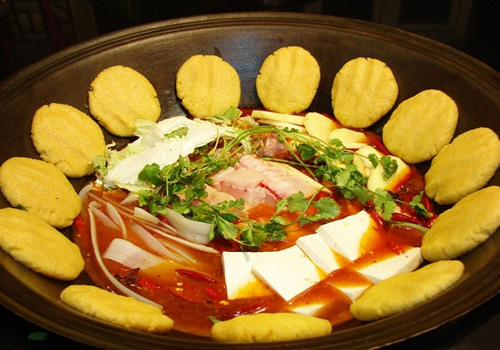
Fish and tofu stewed in iron pot & corn cakes in Northest China
In the same period, however, in south China Zhejiang Province, spring thunder awakes bamboo shoots in Tianmu Mountain. People here live on bamboo shoots and harvest season lasts only one month a year. Thunder bamboo shoots are crisp and tender, taste delicious no matter fry, stew or braise. Bamboo, native in China, is also the foremost source of income for 150 000 people live in Lin’an City. Bamboo shoots here are usually processed to a delicacy, muti-flavored dried bamboo shoots, the most fashionable snacks with tea in the area.
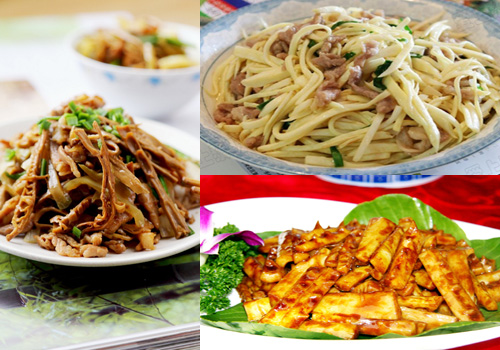
Diversified dishes made from bamboo shoots in Zhejiang
Spring, everything comes to life, crops temporary shortage, but rich edible wild herbs raging. Smallage and artrmisia selengensis by Poyang Lake in Jiangxi, pickled magnolia buds and steamed elm seeds rice in northern mountain areas, and in Shangfang mountain of Beijing, Chinese toon buds sprouts; it is fried after rolling in batter, shredded to make scrambled eggs, or make salad with tofu. Spring is also the season to transplant rice seedlings; peasants in Shangbao Town in Jiangxi now make nine-layer cake to lay their hopes. Grind rice milk, to make the first layer green with leeks, use gardenia fruit to make earthy yellow, then white color itself, and festive red by tomato. Add one layer to be steamed after another for nine times. Green means verdant rice seedlings in spring, to harvest golden unhusked rice in autumn for white rice, then lead to a hot-red life (means good life in Chinese), these are the wish of all rice peasants.
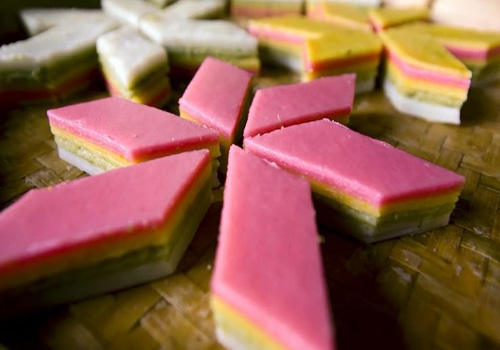
Nine-layer cake of Shangbao Town, Jiangxi Province
The time has come to early summer, a season of spiral shells in the middle and lower reaches of Yangtze River. Since ancient times, spiral shells are popular on the table of people live by rivers. The best spiral shells are found in deep mountains and need to catch in deep night. Qualified clear water spiral shells taste smooth with slight bitter, and usually cooked with purple perilla.
Orchid Island of Taiwan, a volcanic island occupied by Yami people who eat flying fish and believe in flying fish. Every March to June is the season of flying fish. Yami people catch several fresh fish each day for the day and catch in large quantities in the end of fishing season to make dried fish for off season. It is simple to make dried fish by simply preserving the fish, then expose them in the sun for 3 days. Dried fish can eat directly or simply cooked.
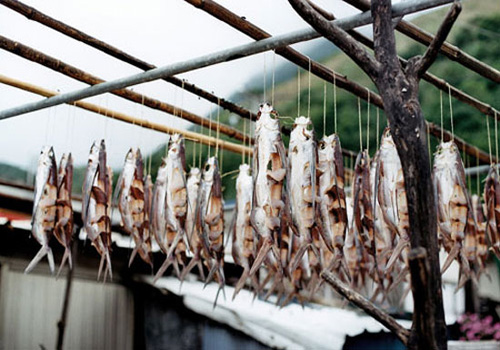
Hanging flying fish for drying in Orchid Island, Taiwan
Sliced noodles is a typical snack in Wuhu all the year round, but taste most delicious in summer with shrimp roe. Only in high summer when water temperature exceed 18 degree centigrade, freshwater shrimp starts to breed. 1kg shrimp offers 50g roes and one person can only collect 8kg roes a summer. Cook sliced noodles on high fire, then seasoned by chopped green onion, soy sauce, bone broth and surely, shrimp roe, a toothsome food is done.
Turpan, extreme drought, the hottest region in China, boasts China’s sweetest grapes. Sufficient sunshine and active photosynthesis assist grapes to accumulate sugar. Ripe grapes are hanged in airing room to be dehydrated by time. When raisins done, it is the time to make hand pilaf for celebration. Xinjiang special yellow carrot, mutton, tomato and raisin can create a rich flavored hand pilaf. Hotan, offers sweeter grapes than Turpan, uses grape juice to make a high-calorie dessert, Xinjiang Nut Cake. Boil grape juice on the fire of 115 degree centigrade, when juice concentrate to syrup, mix in baked walnut kernel.
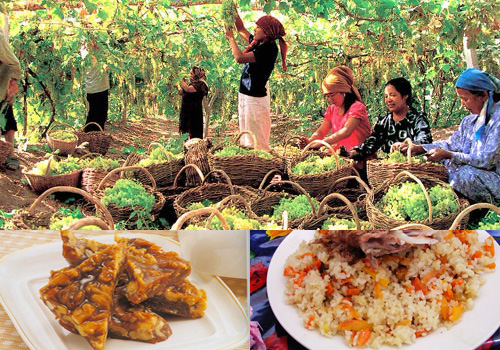
Xinjiang grapes & nut cake & hand pilaf
Suzhou Qidu Town, tempting sweet aroma floats, it is the season to make autumn sweet osmanthus sauce. After the first autumn rain, it’s time to Pingqiao Town to pick lactarius deliciosus, a dainty chased by gastronomes and grows under pine tree and chestnut tree when wild goose fly here. Fry dried red pepper, add in fresh ginger and lactarius deliciosus, then use some soy sauce to boil lactarius deliciosus sauce, a great partner of old duck. Autumn, also the harvest season of chestnut, a good match with chicken, while bundled pork liver made with oily tofu and pork is the best food to satisfy appetite of the season. It is a tradition in China’s agricultural society to eat heavy taste dishes to make up for the loss of appetite in summer and withstand the coming chilly winter.
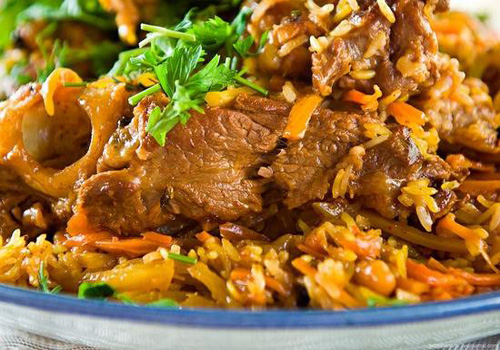
Old duck stewed with lactarius deliciosus of Pingqiao, Jiangsu Province
Northeast China enter into winter at the earliest time. After a heavy snow, soil freeze-up, people store food for the long winter. Winter, a resting season for both soil and crops, and further, a time for Chinese to go back home far away for a reunite to reward with food for one year’s busy work. Before Spring Festival, billions of people set food on the journey home, with simple belongings, use any transportation, anxious to return home for a New Year’s Eve dinner, an imprint on modern China left from agriculture civilization. In our time, everyone go through pains and joys; Chinese always hide their pains in the heart but change joys to food to be presented on our four seasons’ dinning table.
--- By April (VisitOurChina)
Preview:A Bite of China II - Heart's Message, a way of transmitting Chinese food cooking
Next:A Bite of China II - Daily Domestics, common but unforgettable home-cooked foods




